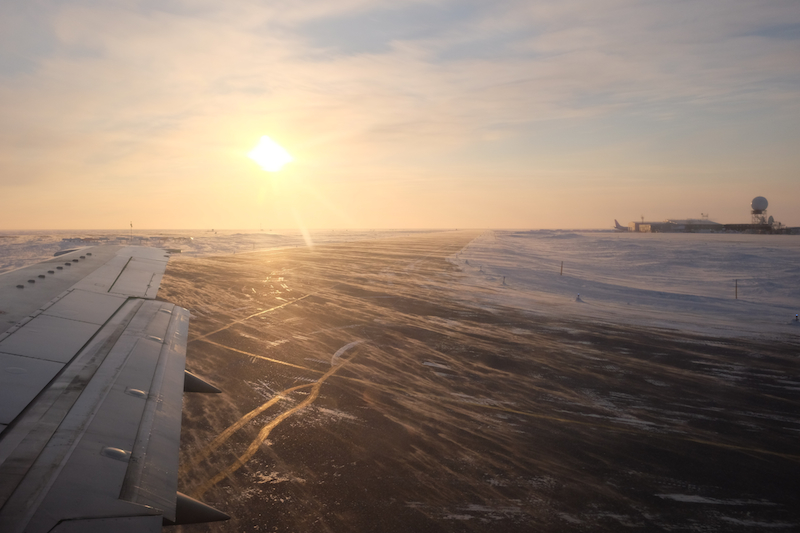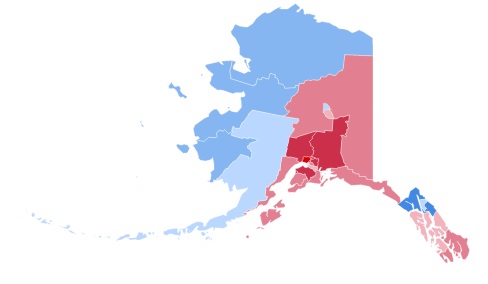Blog: Trump’s budget could cause infrastructure crisis for rural and native Alaskans

U.S. President Donald Trump released his proposed budget, and the reaction has been swift and scathing. Rural communities, healthcare, the environment, science, and climate change research all face enormous cuts.
Trump may have run a campaign on behalf of the common man. But given that the president spends half of his time running the government from the palatial Mar-a-Lago, it’s painfully obvious that he cares little about the fates of some of the nation’s most vulnerable people and places.
Rural America, much of which ironically voted for Trump, will have to contend with deep funding cuts if his budget is approved. As a state with one of the highest proportions of rural residents, Alaska would be particularly negatively impacted. Some 34% of Alaskans live outside the state’s cities. Alaska’s rural populations, too, are different than those in the Lower 48. While much of rural America voted for Trump, counties with large Alaska Native populations tended to vote for Clinton. (The same is true of rural, largely Native American counties in the Lower 48). Between 2008 and 2012, rural Alaska actually had some of the largest shifts in voting: many counties that had opted in 2008 for the Republican presidential candidate, John McCain, voted in 2012 for Barack Obama. This may reflect the fact that an Alaskan, Sarah Palin, was no longer on the ticket.
Yet it may also suggest that rural Alaska Natives believe that a Democratic president may do more for them than a Republican. Indeed, it’s hard to imagine Trump taking a tour of Alaska to witness climate change first-hand and visit Alaska Native settlements. Obama’s visit to Kotzebue made him the first sitting president to visit the American Arctic. In contrast, Trump proposes to eliminate the very agency that Obama tapped to lead the process of climate change mitigation in coastal communities in Alaska, including determining which ones should be relocated. Unsurprisingly, then, in 2016, rural Alaska again tended to vote Democratic.
If Trump’s budget is approved, Alaska Native villages could face an infrastructure crisis. During the campaign, Trump talked big about planning to ask Congress for a trillion dollar infrastructure bill. But maybe he had in mind a few big-ticket projects like pipelines and ports, for his budget proposes to make deep cuts in federal funding to vitally important small-scale infrastructure that supports rural livelihoods in Alaska. Trump wants to pay for a “big, beautiful, wall” to ostensibly keep out illegal immigrants from Mexico and Central America. He doesn’t want to pay for shore walls in Alaska that would keep out a rising sea.

Here’s a rundown of how Trump’s budget would jeopardize infrastructure and well-being in rural Alaska.
• Scraps programs like the Essential Air Service, which provides $21 million a year to guarantee air service to 61 communities in Alaska that otherwise would be viable in a market situation, and the Low Income Home Energy Assistance Program, which reduces the cost of heating for people with extremely high bills in places like frigid Alaska. People living in communities in the Lower 48 that lose air service due to the elimination of EAS may just have to drive longer distances, but that isn’t an option in Alaska. As the state’s sole representative to Congress, Don King (R), remarked last year, “That’s what serves my community… I don’t have highways. I don’t have streets. I’ve got air.”
• Eliminates the Economic Development Administration, which the budget considers a “duplicative administration” even though it is the only federal agency exclusively focused on economic development. The EDA assists with regional development in places like Alaska, Appalachia, the Deep South, and New England. In 2013, EDA invested $838,155 in 12 projects in the State of Alaska. According to its website, its “investments help Alaska communities achieve bottom-up, locally-defined economic development goals and strategies.” Of the funds in 2013, nearly half ($370,000) went to six American Indian/Alaska Native economic development planning organizations in the state. The EDA has invested in Alaska Native communities since its establishment in 1965. The village of Gambell, on St. Lawrence Island halfway between Alaska and Russia, received $11,500 in the 1960s for its restoration. In the below photo from the EDA, the native Yupik people prepare an umiak (walrus-skin boat) in Gambell. One example of a more recent program that the EDA has funded in Alaska is a $700,000 investment in workforce development in rural Alaska, granted in May 2014. The grant went to the Association of Village County Presidents in Bethel to purchase equipment used to train workers in mechanical disciplines, including aviation maintenance. This is a crucial skill in a region where many rely on small planes for transportation between remote villages. This program and many other similar ones once funded by the EDA may now no longer be possible.
• Eliminates infrastructure assistance to Alaska Native Villages provided through the Environmental Protection Agency. This is one of the over 50 EPA programs the budget would cut due to being categorized as “lower priority and poorly performing programs.” Through its Alaska Native Villages and Rural Communities Water Grant Program, the EPA has provided over half a billion dollars in grants since 1995 to assist with clean water provisioning. At least 3,300 homes in rural Alaska, mostly in the western portion of the state, lack running water or flush toilets.
• Cuts the budget for the Hazardous Substance Superfund Account by $330 million. There are eight active Superfund and Superfund-equivalent sites in Alaska including severely contaminated mine and military sites. Local and state governments would be expected to fill in the funding gap – but given Alaska’s nearly $3 billion budget deficit, this seems unlikely.

• Overall, appears to cut research to climate change by 20%. Alaska is warming twice as fast as the Lower 48, making climate change research even more urgent. Even as climate change opens new opportunities for Arctic development, it threatens many coastal communities. Some of them, like Kivalina and Shishmaref, may even have to relocate inland to avoid rising sea levels, eroding shorelines, and more severe storm surges, as this report by the Army Corps of Engineers explains. The budget would cut funding to the National Oceanic and Atmospheric Administration, part of the Department of Commerce, by $250 million. Specific programs targeted include coastal and marine management, which could unduly affect Alaska since its 6,640 miles of coastline are longer than the coastlines of all other states combined. Trump’s budget argues that coastal and marine management takes “lower priority than core functions maintained in the Budget such as surveys, charting, and fisheries management.” But successful fisheries are dependent on well-managed coasts. A study involving NOAA found, for instance, that ocean acidification puts Alaska fisheries and communities at high risk, particularly in the southeast and southwest where many depend on the sea for their livelihoods. According to a NOAA report, in Alaska in 2012, the seafood industry provided 55,890 jobs and accounted for over a billion dollars in landings revenue – a third of the nation’s total and nearly triple the next highest state, Massachusetts. If Trump thinks that this lucrative industry can be maintained without research into coastal management and climate change, he is wrong.
• Eliminates the Denali Commission, which was formed in 1998 by legendary Alaska Senator Ted Stevens (R) to help rural Alaska Native communities obtain infrastructure, health care, and job training. The commission has had its ups and downs, including an internal fiasco in which its own leader suggested it should be axed. Yet Obama’s decision to allocate $2 million to the commission to lead a project determining which coastal villages should be relocated gave it a new and important role. The Trump budget may now yank this away. Coastal communities in Alaska are counting on the government to step in to help them combat climate change. In 2015, Diane Ramoth, vice chair of the Selawik tribal government council and treasurer of the NANA Regional Corporation, expressed, “This is a very, very dire situation that we’re in if our United States government is going to allow our communities to no longer exist.”
There is something even more dire than the current administration’s wish to eliminate a commission assisting the 31 coastal communities that may potentially slide into the sea. It is that the president seeks to undercut many of the basic services, programs, and subsidies that make modern life possible in the hundreds of communities across rural Alaska, climate change or no climate change. In the 19th and 20th centuries, the U.S. government effectively forced Alaska Natives to settle in place. But now, it does not even want to pay to support the infrastructure that people have become locked into. Under Trump, Alaska is no longer the Last Frontier, but rather the Forgotten Frontier.

What’s one big area with regard to Alaska that isn’t being defunded? Support for the oil industry. The President’s 2018 budget plans to “strengthen the Nation’s energy security by increasing funding for Department of Interior programs that support environmentally responsible development of energy on public lands and offshore waters.” This could possibly pave the way for more drilling in places like the National Petroleum Reserve-Alaska, America’s largest tract of undisturbed public land.
More drilling may be good news for the Alaskan state budget and all of its residents who receive Permanent Fund Dividends every year. But you can’t do much with money if you have no air service, no clean water, no job training, and no climate resilient infrastructure – except maybe pay for your skyrocketing heating bill, no longer subsidized under Trump.
This post first appeared on Cryopolitics, an Arctic News and Analysis blog.
Related stories from around the North:
Canada: Trump’s election a cold reality check for Arctic, Blog by Mia Bennett
Denmark: Obama and Nordic leaders pledge Arctic cooperation, Alaska Dispatch News
Finland: Finland talks Arctic with Trump, YLE News
Greenland: Greenland, Alaska elections bolster Arctic resource extraction, Blog by Mia Bennett
Sweden: Sweden’s climate minister worried about Trump’s stance on global warming, Radio Sweden
Switzerland: Arctic climate (anti-)Trump card in Davos, Blog by Irene Quaile, Deutsche Welle
United States: Trump budget cuts deeply into Alaska’s federal funding, Alaska Dispatch News




